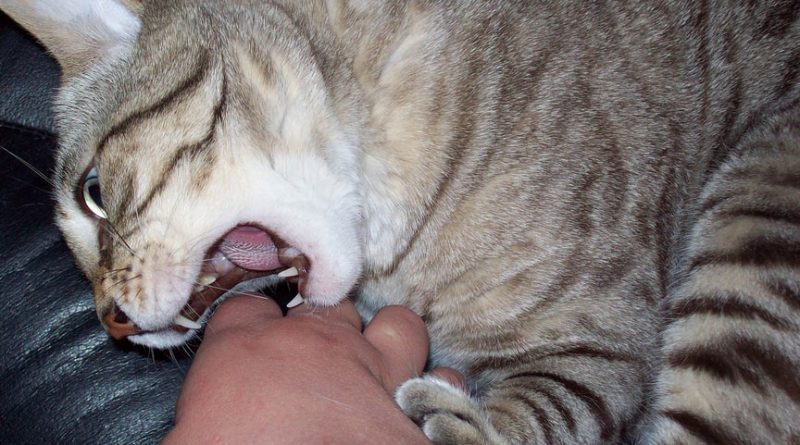Five Steps to Teach Your Cat to Stop Biting
One day it will dawn on you. You’ll be sitting, mulling over what a fascinating novel your life would make, when something occurs to you: Your cat is capable of attacking little children. And — deep sigh — it’s all your fault.
You’ve played too rough, too often and loved every minute of it.
Somehow, according to sources, during playtime, we’re supposed to teach our cats to be gentle, careful creatures. They suggest we teach our cats to never use claws, and never bite.
There’s a lot of information on the web about training cats not to bite. As best I can surmise, these five steps are the most widely accepted:
1. Use Playtime to teach your cat how to play.
What? I’ve been doing this all wrong. I use playtime to learn how my cat likes to play.
No wonder I walk away a bloody mess.
According to Cornell University Vet School, “You can systematically discourage your cat’s petting-induced aggression with the following tactics: Entice your cat onto your lap with a tasty treat, and lightly stroke him. Well before you detect his aggressive warning signs, place him on the floor with a treat to reward his peaceful behavior. Gradually increase the length of time you spend petting him, and he will learn that calm interactions are followed by treats.“
2. Be realistic and patient.
Um. Yeah. They are cats. I assume if you’re reading this article, your cat has you well-schooled on your need for more patience.
3. Learn the Imma-lose-it-any-minute warning signs.
You can only do this by playing with the cat. After a while, you’ll notice how his body language changes when he’s about to go bonkers. Again, if you’re reading this article, you’re probably well-acquainted with step 3.
A tensed body, flattened ears, and a lashing tail are typical warning signs. Also, keep in mind that kids don’t really understand animal body language yet. If you have young ones around, be sure and teach them about these warning signs and various cat postures so they don’t have to learn that lesson the hard way.
4. Stop Petting Abruptly.
Really, all of this boils down to #4. Your cat will hate it when you stop playing abruptly and for most cats that will be enough to teach him to stop biting.
In other words, once you see the warning signs, stop immediately. Your cat wants to play and will modify their behavior as needed to keep playing. But, it’s a slow process and most likely won’t be accomplished in one or two play sessions. Patience is key.
5. Accept the Cat.
Your cat has limits, boundaries, quirks — you know, a personality. He will like certain things and have a distaste for others. He will like something one minute and completely lose interest the next. He may not be a cuddle bunny. It’s our job to accept them as they are.
If your cat isn’t picking up what you’re putting down, there may be some underlying issues that should be addressed by a cat behaviorist and a veterinarian.
I don’t have a particularly gentle, careful cat, so I’m going to work my way through this list and get back to you if I notice any improvements. Feel free to chime in with your experience too.
Featured Photo by: Kniemla
https://iheartcats.com/9-tips-to-stop-a-biting-cat/
http://raleighncvet.com/2016/01/15/raleigh-nc-vet-teaching-kitten-not-bite/
http://www.vet.cornell.edu/fhc/Health_Information/brochure_destructive.cfm



